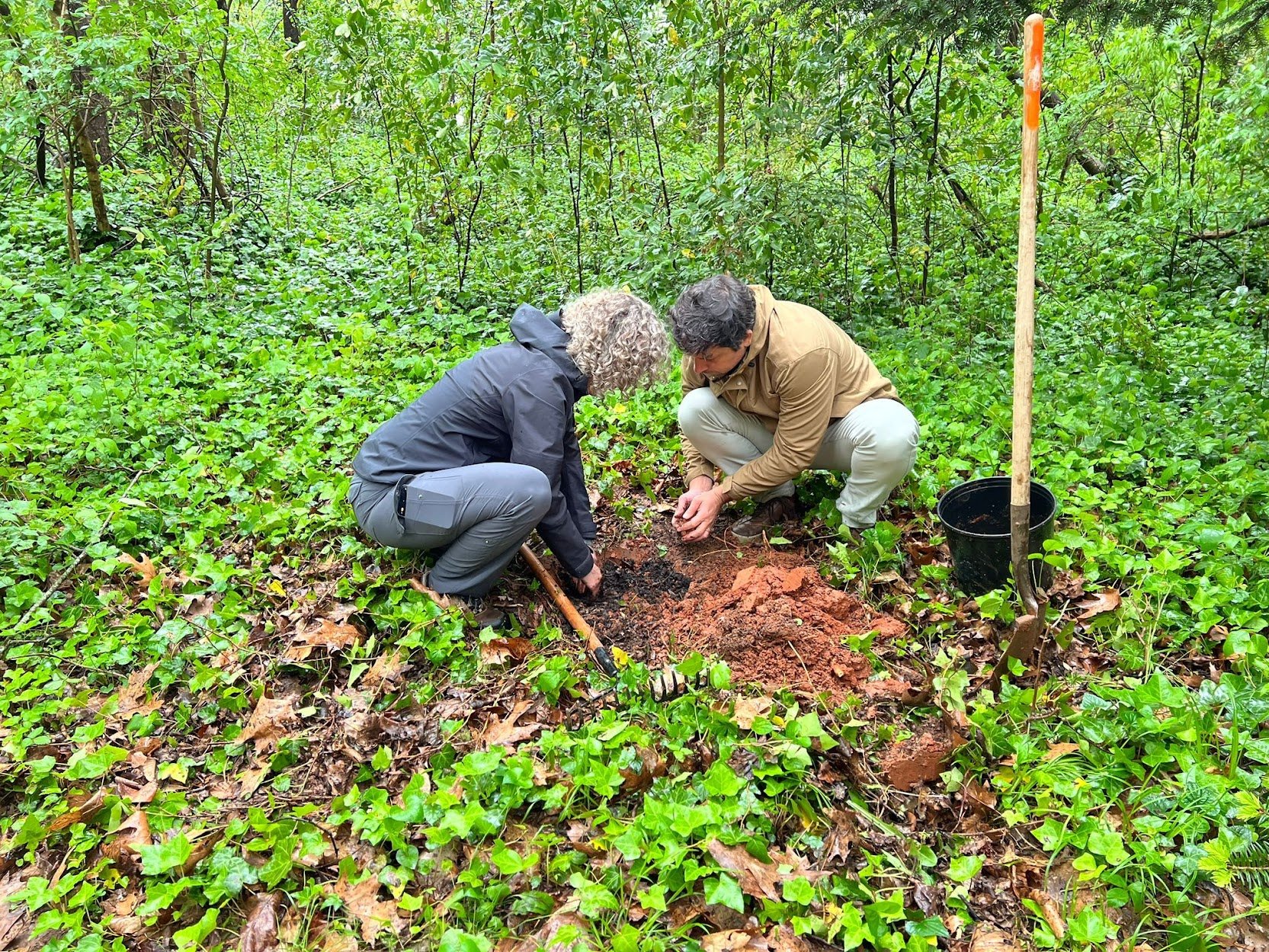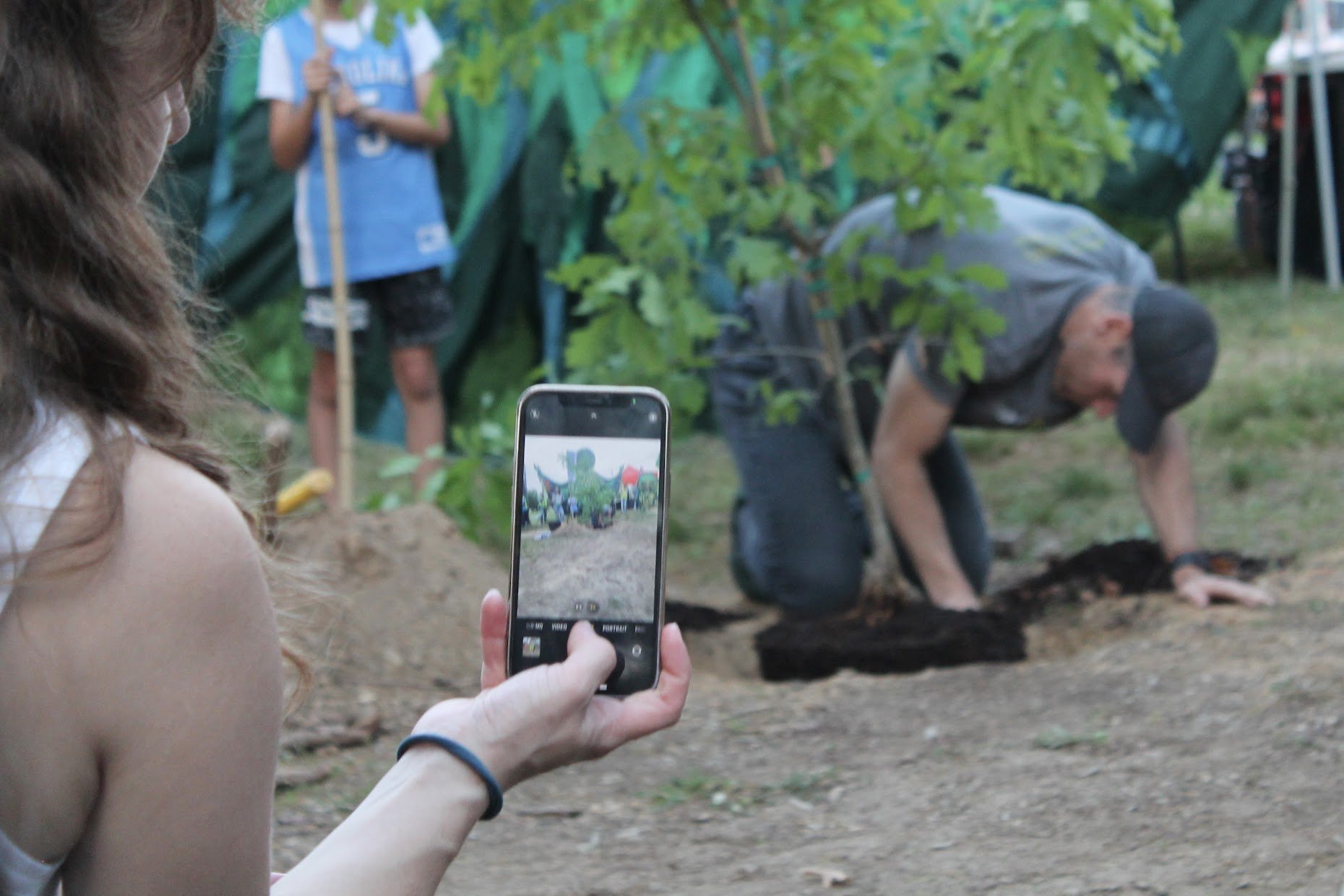
Resources
How to Plant Trees
Learn when, where, and how to plant, plus tips on compost, watering, and helping your tree grow strong.
Getting started
Before you plant, it is important to choose the right tree for the right space. Consider your space’s unique conditions, your local microclimate, and your hardiness zone to give your tree the best chance to thrive.
1. Identify the the right place to plant
Before choosing a tree, take time to understand the unique microclimate of your planting site. Microclimates are small, localized conditions that can vary even within the same space—and they play a big role in your tree’s long-term health!
Here are a few key factors to consider:
Sunlight — How much direct sunlight does the area get? Is it full sun, partial sun, dappled shade, or mostly shaded?
Soil moisture — Does the soil drain quickly, stay damp, or become soggy after rain?
Irrigation — Will the tree have consistent access to water from rainfall, irrigation, or nearby runoff?
Wind exposure — Is the area protected, or is it exposed to strong or frequent winds?
Understanding these conditions will help you choose a tree that is well-suited to your space and more likely to thrive. If you need help identifying your microclimate, feel free to contact us.
2. Explore native species
Before selecting a tree to plant, it is also important to understand the difference between native, introduced, and naturalized species:
Native trees are species that naturally occur in your region’s ecosystem—they have evolved alongside local wildlife and are best suited to the climate and soil.
Introduced trees are species brought from other regions or countries, often through landscaping or trade.
Naturalized trees are introduced species that have adapted to the local environment and now grow and spread in the wild.
Whenever possible, choose native trees! They are better adapted to your microclimate, require less maintenance, and provide essential habitat and food for local wildlife.
Want help identifying native species in your area? Reach out to local nurseries, certified arborists, university extension programs, or your city or county parks department—they are great resources for regional guidance. You are also welcome to contact us.
3. Know when to plant
Timing matters when it comes to planting a tree. Choosing the right season can give your tree the best chance to establish strong roots and adapt to its new environment. While you can technically plant a tree in most seasons, each comes with its own conditions to consider.
Here are some general guidelines to help you decide when to plant:
Spring — A great time to plant, especially early in the season before the heat sets in. Be prepared to water regularly as temperatures rise.
Summer — Summer planting is possible, but avoid the hottest, driest weeks. If temperatures stay below 75°F (24°C) and you can water deeply and weekly, your tree can still thrive.
Fall — The ideal time to plant! Cooler weather and dormant growth help reduce stress on the tree. Fall planting gives roots time to establish before the next growing season.
Winter — In milder climates, you can plant in winter as long as the ground is not frozen or covered in snow. Just take extra care not to disturb roots during harsh conditions.
4. Know where to plant
Before choosing a tree to plant, it is important to know your hardiness zone—a classification that helps determine which trees will survive in your region’s climate.
Zones are based on the average annual minimum temperature, and they guide you in selecting species that can handle your area's seasonal extremes. Knowing your hardiness zone will help you choose trees that will thrive year-round, while avoiding trees that cannot survive your unique winter and summer conditions.
If you are unsure which zone you are in, many national or regional gardening organizations offer interactive tools to help you find out. For example:
If you need more help identifying your hardiness zone, feel free to contact us.

Don’t miss our next event
Visit We Plant it Forward’s online calendar to stay up to date on upcoming events and volunteer opportunities in the community, including tree plantings, tree giveaways, and more!
Planting a tree
From digging the hole to the first watering, these resources will walk you through everything you need to give your tree the best start.
Video tutorials
Below you will find our instructional video tutorials, where we demonstrate how to properly plant both bare root and containerized trees. If you encounter any technical difficulties, or have any follow-up questions about tree planting, please feel free to contact us.
1. How to plant a bare root tree:
2. How to plant a containerized tree:
The planting process
Planting your tree correctly is one of the most important steps to ensure it thrives for years to come. Below is a detailed illustrated diagram showing the key elements of a successful planting. Use it as a visual guide as you follow these essential steps:
Dig the right-sized hole — Dig a hole at least 3 times the width of the root ball. This gives roots room to spread out and establish themselves.
Prepare the root ball — If your tree’s root ball is wrapped in natural burlap, gently roll down the top third to keep it away from the trunk. Remove any non-biodegradable materials completely.
Set the tree at the proper height — Place the tree in the hole so the root crown sits about 1 inch above the final soil grade. This prevents root rot and encourages healthy growth.
Backfill with soil — Fill in around the root ball using a planting soil mix, lightly tamping it down to remove air pockets.
Add mulch — Apply a 3-inch layer of mulch around the base of the tree, keeping it a few inches away from the trunk. Mulch helps retain moisture, regulate temperature, and reduce weeds.
Water thoroughly — Use gator bags or a slow, deep watering method to help the tree settle and stay hydrated during its early growth.
To better visualize a successful planting, please see the detailed illustrated diagram below:
Click the image to view in full size.
Drawing by Cindy Rice.
If you have additional questions about the tree-planting process, please feel free to contact us.

Discover the benefits of trees
Did you know that trees help cool the Earth, reduce energy consumption, filter pollutants, and more?
Take time today to learn how trees benefit us all!
Watering a tree
Proper watering is one of the most important steps in helping your tree establish strong, healthy roots.
How to water properly
Shallow watering—like using a sprinkler or quick spray from a hose—encourages roots to stay near the surface, making the tree more vulnerable. Instead, aim for a slow, deep soak that allows water to reach well below the root ball. Below are some of the best methods to water newly planted trees:
A circular bag that lies flat on the ground around the tree and slowly release water directly to the roots over several hours.
Donut irrigation bag
Upright bags that zip around the base of the tree and slowly release water directly to the roots over several hours.
Gator irrigation bag
Rain barrel
Collect rain as a non-potable water source for eco-friendly irrigation.
Click here to learn more!
If you have additional questions about proper watering, please feel free to contact us.

Looking to get involved?
At We Plant it Forward, we bring people and nature together. We’re always looking for partners, interns, volunteers, collaborators, and sponsors.
Join us in planting seeds of environmental change!
Compost and soil
Healthy soil means healthy trees. Explore composting resources to learn how to turn everyday food and yard waste into nutrient-rich soil that supports strong root growth and long-term tree health.
Get started with composting
Composting at home is a simple, sustainable way to turn kitchen scraps and yard waste into nutrient-rich soil. By keeping organic materials out of landfills, you reduce waste and create a natural fertilizer that helps your trees, garden, and plants thrive. Explore these resources to get started with composting at home!
Website articles:
Beginner’s Guide to Home Composting by HomeHow
Supplies for Composting by Eartheasy
Composting Resource for Beginners Through Experts by HowToCompost.org
Environmental Home Remodeling: Recycling and Composting by HomeAdvisor
Composting Articles and Videos by Planet Natural
Published books:
Let It Rot: The Gardener’s Guide to Composting by Stu Campbell
Vermicomposting with worm bins
Worm composting—also known as vermicomposting—is an easy and natural way to recycle food scraps into rich, healthy soil for your trees and garden. Worm bins help reduce landfill waste while creating nutrient-rich compost that supports strong root growth and soil health. Explore these resources to get started with your own worm bin at home!
Website articles:
A Step-by-Step Guide to Vermicomposting by Mother Earth News
Worm Composting Basics by Cornell Composting at Cornell University
Vermicomposting: All You Need to Know by Planet Natural
Published books:
If you have additional questions about composting, please feel free to contact us.

Connect with us
Stay connected and join the conversation! Follow us on social media for the latest updates, upcoming events, volunteer opportunities, and inspiring stories from our community.




